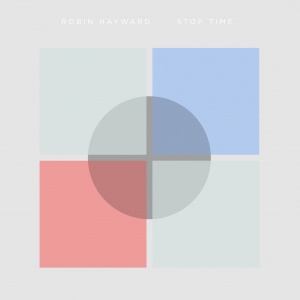 The cover for Stop Time is meant to convey the nature of the tool used to compose it, an invention of Robin Hayward’s called the Hayward Tuning Vine. The idea behind it is to spatialize (and colorize) the relationship between just intervals played, in this case, on a baritone saxophone, a cello, and a microtonal tuba. At the performance from which this album is drawn, each instrumentalist was illuminated in a color corresponding to the pitch he played on the Vine. If the pitch shifted, so did the color. Those pitches were in turn fed to a surround-sound system and projected into different parts of the performance space. In the move to recorded medium, the spatial-visual element is partially flattened, making the slow accrual of rhythm, texture, and harmony the music’s driving feature.
The cover for Stop Time is meant to convey the nature of the tool used to compose it, an invention of Robin Hayward’s called the Hayward Tuning Vine. The idea behind it is to spatialize (and colorize) the relationship between just intervals played, in this case, on a baritone saxophone, a cello, and a microtonal tuba. At the performance from which this album is drawn, each instrumentalist was illuminated in a color corresponding to the pitch he played on the Vine. If the pitch shifted, so did the color. Those pitches were in turn fed to a surround-sound system and projected into different parts of the performance space. In the move to recorded medium, the spatial-visual element is partially flattened, making the slow accrual of rhythm, texture, and harmony the music’s driving feature.
Robin Hayward is a member of Catherine Christer Hennix’s Chora(s)san Time-Court Mirage ensemble, and he’s collaborated with composers like Alvin Lucier, Eliane Radigue, and Christian Wolff. For anyone familiar with Hennix or Radigue, their work makes for a convenient point of reference. Hayward uses few materials—just three instruments, a handful of tones, and a series of sustained pulses. The variety and beauty they create is derived from how they interact within their circular framework.
Throughout the album’s half-hour duration, cello, sax, and tuba revolve around an invisible center, conveying distance and intensity. They stand out in the stereo for a time, solo on a single note (repeated or held), then fall back into an underlying drone. The mix makes good use of stereo to position the instruments too. They seem to trade places, rocking left-to-right and back-and-forth on a smooth, glassy curve; a parallel, maybe, to the ratios of whole numbers used for representing just intonation. By the end, the overall effect escapes into an extra dimension. It’s like listening to someone breathe, or like watching small waves lap against one another in slow motion. The CD may not be able to replicate the visual effects of the live performance, but Hayward’s music relates visual information of its own, both color and light, and the cloudy images from the no-space of dreams.
samples:
 
Read More

